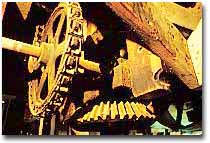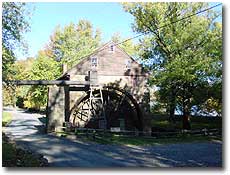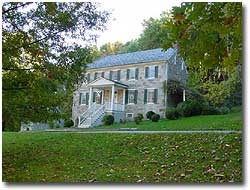Susquehanna River Valley Has Long History
by Ross Kimmel
The history of the Susquehanna River
Valley demonstrates the reliance that pioneer settlers placed on waterways for
both power and transportation. That story is told at Susquehanna State Park.
 Captain
John Smith first explored the Susquehanna River in 1608. It impressed him
favorably. He noted that "heaven and earth seemed never to have agreed better
to frame a place for man's commodious and delightful habitation." During his
journey, Smith met and described the native Susquehannocks, for whom the river
is named.
Captain
John Smith first explored the Susquehanna River in 1608. It impressed him
favorably. He noted that "heaven and earth seemed never to have agreed better
to frame a place for man's commodious and delightful habitation." During his
journey, Smith met and described the native Susquehannocks, for whom the river
is named.
Edward Palmer, an early English
adventurer, established a post on an island at the Susquehanna's mouth in
1622. His purpose was to trade goods to the Indians for valuable furs. In 1637
Lord Baltimore took over the island, and in 1658 early Marylanders founded the
settlement which became today's city of Havre de Grace.
Other settlements grew up along the
banks and tributaries of the Susquehanna. Natural resources such as timber,
coal and farm produce were harvested for man's use and shipped to market down
river. Water powered mills were built along the valley, bridges were built to
join the east bank of the river to the west, and canals were dug along the
banks to provide auxiliary transportation routes. The Susquehanna River Valley
grew into a prosperous and important center of commerce and industry.
Several Historical Buildings Have Been
Restored and are Open to the Public
 Rock
Run Grist Mill
Rock
Run Grist Mill
Several buildings at Susquehanna State Park which are associated with the
river's history have been restored and are open to the public. Rock Run Grist
Mill, erected in 1794 by John Stump, a prosperous businessman who owned
several mills in Harford, Cecil, and Baltimore counties, is a three story
stone structure and is fully operational. Inside are displays of 19th century
farm and mill equipment. The water powered mill is operated during the summer
months.
On weekends between May 1 and Labor
Day, Rock Run Grist Mill comes alive when corn is ground into meal in public
demonstrations held from 1 to 4 p.m. The meal is bagged and given free to the
public. In addition there is a self-guided historical walking tour in the park
with a brochure explaining in greater detail the individual points of
interest. The mansion is open on summer weekends for tours. Reservations can
be made by calling Rocks/Susquehanna State Parks at 410-557-7994.
Between the mill and the river runs a
section of the Susquehanna and Tidewater Canal, which was built in 1836. The
canal linked Havre de Grace with Wrightsville, Pennsylvania. With mule drawn
barges plying its waters, the Susquehanna and Tidewater was a major commercial
waterway until 1889 when the combined efforts of railroad competition and a
flood forced its closing. Two of the canal locks are within the park's
boundary.
Up the river from the mill is a little
white frame building known as the Jersey Toll House. The toll house once
served a covered bridge that spanned the Susquehanna at this point. Across the
road from the toll house is the Rock Run miller's house. A fine stone
building, this structure is now a private residence for park personnel.
 On the hill which overlooks the mill
stands Rock Run House, a majestic 14 room stone mansion built in 1804 by John
Carter, a partner of John Stump in the Rock Run Mill. When Carter died a year
later the house passed to the Stumps' daughter Ann and her husband, Dr. John
Archer, Jr. One of the Archer's children was James J. Archer, a general in the
Confederate Army. Several rooms are restored and furnished with period
antiques. Associated with the mansion are a large stone barn and a stone
spring house. The barn houses examples of early farm equipment and water still
runs clear and cold in the spring house.
On the hill which overlooks the mill
stands Rock Run House, a majestic 14 room stone mansion built in 1804 by John
Carter, a partner of John Stump in the Rock Run Mill. When Carter died a year
later the house passed to the Stumps' daughter Ann and her husband, Dr. John
Archer, Jr. One of the Archer's children was James J. Archer, a general in the
Confederate Army. Several rooms are restored and furnished with period
antiques. Associated with the mansion are a large stone barn and a stone
spring house. The barn houses examples of early farm equipment and water still
runs clear and cold in the spring house.
At the lower end of the park is the
community of Lapidum. This settlement traces its history to 1683 with the
granting of land patents for the tracts "Paradise," "Elberton" and "Vincent's
Castle." As the surrounding land was transformed from wilderness to farmland,
Lapidum grew in importance as a commercial center. Corn and tobacco grew along
the river bank at Lapidum and a bustling fishing industry developed here.
Steppingstone Museum
Another attraction to see while you are in the area is Steppingstone Museum.
Located within Susquehanna State Park, the Museum is a private, not for profit
museum which preserves and demonstrates the rural arts and crafts of the
1880-1920 period. The collection of hand tools was started by J. Edmond Bull
and augmented by many local gifts. By special agreement, the museum is jointly
sponsored on a non-funding basis by the Maryland State Forest and Park
Service. Museum volunteers and a limited staff operate the museum and organize
special events, one of which is the annual Civil War Day on the first Sunday
in May. This event features period music and infantry and artillery
demonstrations.
Visitors can see the sights of a once
working Harford County farm. The farmhouse, furnished as a turn-of-the-century
country home, charms the visitor as a guide invites you to share the daily
life of the period. Tours include the formal sitting room, sleeping quarters,
and kitchen with its wood burning stove and ice box.
 The
nearby shops and the display barn hold many examples and exhibits which
support the industries and implements of the farm family. Visitors are
encouraged to discuss the craft skills with volunteers. A gift shop features
some of the handcrafted articles produced by Steppingstone friends. Also plan
to visit the Decoy Shop located under the barn and see how a decoy is carved
and painted.
The
nearby shops and the display barn hold many examples and exhibits which
support the industries and implements of the farm family. Visitors are
encouraged to discuss the craft skills with volunteers. A gift shop features
some of the handcrafted articles produced by Steppingstone friends. Also plan
to visit the Decoy Shop located under the barn and see how a decoy is carved
and painted.
Steppingstone offers a variety of
pre-arranged tours for school groups, civic organizations and senior groups. A
minimum number of visitors is required and the museum reserves the right to
cancel tours in the event of bad weather. To arrange a tour, please call the
museum office in advance at 410-939-2299. The museum has available for rent a
picnic pavilion and grounds for weddings, reunions, club functions and private
parties. For more information on prices and dates contact the museum office at
the number above.
Individuals and families who wish to
participate more fully in the activities of Steppingstone, may purchase a
membership which helps preserve the history of this bygone era. Members of the
association are admitted into the museum and special events free of charge,
receive the monthly newsletter "Steppingstones," attend an annual members
dinner and work on various committees to plan museum programs and functions.
Exelon Corporation Donates Roberts Island To State:
Susquehanna Park
Now Includes a Landmark along the Chesapeake National Water Trail
On Sept. 21,
2006 on behalf of Maryland’s citizens, Governor Robert L.
Ehrlich, Jr. accepted the gift of Roberts Island in Harford County
from Exelon Corporation, one of the nation’s largest electric utilities.
At the event overlooking the waters of the Chesapeake Bay, Conservation
Fund Chairman Emeritus Patrick F. Noonan joined the Governor in announcing
new efforts to support the Captain John Smith Four-Hundred Project, an
educational initiative retracing Smith’s historic Chesapeake Bay voyages.
“On behalf of the citizens of the State of Maryland, I am pleased to
accept the gift of Roberts Island from Exelon Corporation,” Governor
Ehrlich said. “The island is rich in Native American history, and will be
a welcome addition to Susquehanna State Park as well as an important
landmark along the Chesapeake National Historic Water Trail.”
Susquehanna State Park
Acknowledgements:
The editor of this
article relied heavily on the original work of Ross Kimmel, who wrote an
article for PARKLINE, Summer 1991 issue. Information has been added to bring
Mr. Kimmel's original article up-to-date.